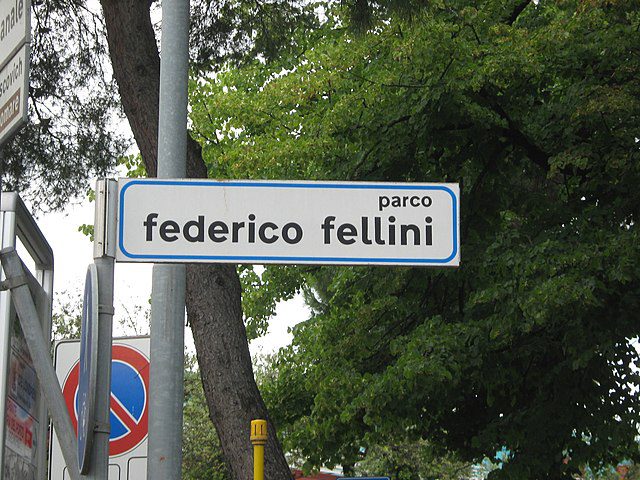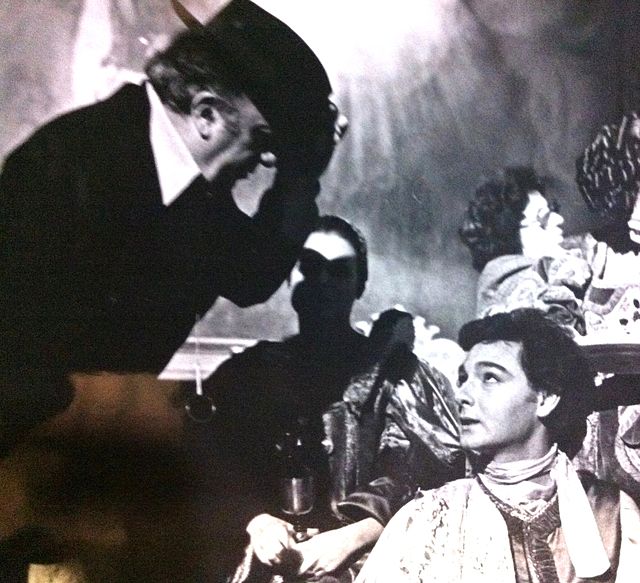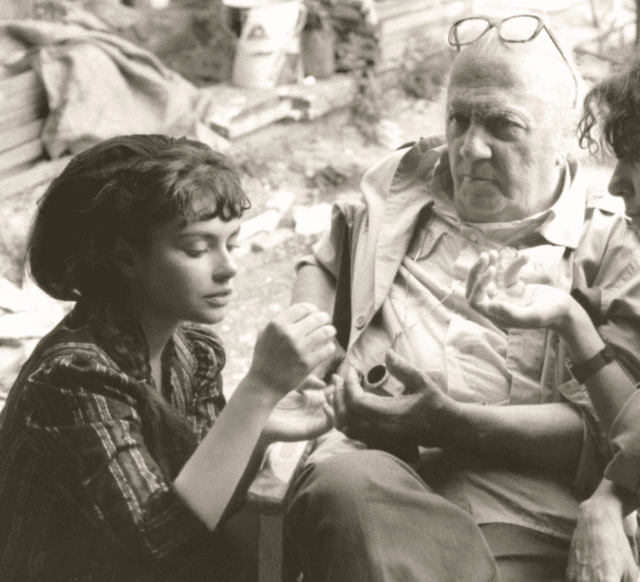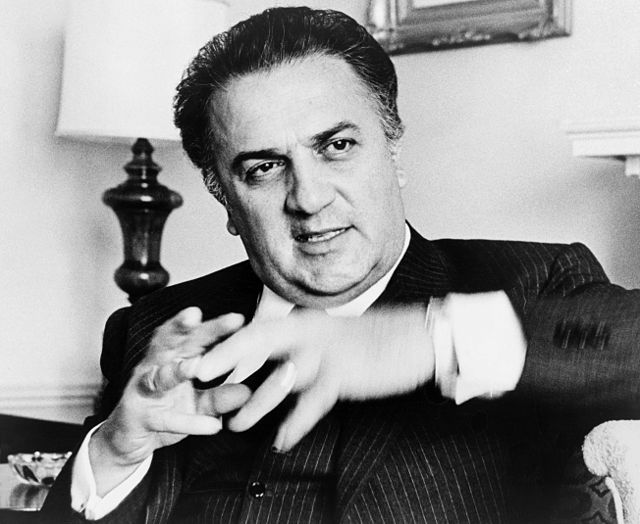Top 10 Fascinating Facts about Federico Fellini
Fellini was a flamboyant Italian master whose genius still looms large over the history of cinema.
In a directorial career spanning four decades, Federico Fellini became Italy’s most celebrated filmmaker, but in recent years, while the critical stock of his contemporaries Pier Paolo Pasolini and Michelangelo Antonioni has remained high, you get the feeling that Fellini’s has taken a bit of a dip.
1. Fellini has produced some of cinema’s most breathtaking moments

Federico Fellini. Photo by Rulo – Wikimedia Commons
This might seem odd, especially when you consider that La dolce vita (1960) and 8½ (1963) remain cinephile staples. It could be that the many films he made on either side of this golden diptych haven’t been fully appreciated – especially those from the 1970s and 80s – but there can be little doubt that his ever-playful, loose, carnivalesque approach (both in terms of sound and image) has produced some of cinema’s most breathtaking moments.
2. His early life and influences

Federico Fellini in the Seventies. Photo by Shaka at Italian Wikipedia – Wikimedia Commons
The son of a traveling salesman who sold foodstuffs and a mother who believed that, in marrying beneath her, she betrayed her links to Roman nobility, Fellini grew up believing he belonged in Rome.
In the late 1930s, he moved there with his mother and brother. Only Federico stayed on, however, surviving by selling cartoons, gags, and stories to the humor magazine Marc’Aurelio. During World War II Fellini wrote scripts for the radio serial Cico e Pallina, starring Giulietta Masina, who became his wife in 1943 and who appeared in several of his films during an often troubled 50-year marriage.
3. Fellini met director Roberto Rossellini in 1944

Federico Fellini. Photo by Italiamia – Wikimedia Commons
In 1944 Fellini met director Roberto Rossellini and became one of a team of writers for Roma, città aperta (1945; Open City or Rome, Open City), a pioneer film of Neorealism. Fellini’s contribution to the screenplay earned him his first Oscar nomination.
4. Fellini quickly became one of Italy’s most successful screenwriters

Federico Fellini park in Rimini. Photo by Igor Oshkin – Wikimedia Commons
Fellini quickly became one of Italy’s most successful screenwriters. He collaborated on screenplays for such directors as Pietro Germi (Il cammino della Speranza [1950; The Path of Hope]), Alberto Lattuada (Senza pietà [1948; Without Pity]), and Luigi Comencini (Persiane chiuse [1951; Behind Closed Shutters]); he was uncredited on the latter film.
In addition, Fellini contributed to Rossellini’s Paisa (1946; Paisan) and Il miracolo (1948; “The Miracle”, an episode of the film L’amore), in which he also acted, playing a tramp who impregnates a simple-minded peasant when she takes him for the reincarnation of St. Joseph.
5. Fellini’s quest for a more personal style alienated Neorealist purists

Fellini federico wardal. The worldwide Cinema Author Federico Fellini with Count of Wardal. Photo by Count Federico Wardal – Wikimedia Commons
Fellini’s quest for a more personal style, which often verged on the fantastic, alienated Neorealist purists. His directorial debut, Luci del varietà (1950; Variety Lights), made in collaboration with Lattuada, is set in a traveling variety show.
An enthusiast of the seedy side of show business, in particular vaudeville and the circus, Fellini returned to this milieu repeatedly, beginning with his first independent feature, Lo sceicco Bianco (1952; The White Sheik ), a satire on the fumetti (photographic comic strips) and their fanatical fans.
6. His first critical and commercial success, I vitelloni exhibited little fantasy

Chrisitiana Visentin Gajoni with Federico Fellini. Photo by ErmanSSe – Wikimedia Commons
However, his first critical and commercial success, I vitelloni (1953; Spivs or The Young and the Passionate), exhibited little fantasy. Based on his adolescence in Rimini, faithfully reflects the boredom of provincial life, which drove him to Rome.
With La Strada (1954; “The Road”), Fellini returned to the world of showmen. It starred Anthony Quinn as Zampanò, a brutish but phoney itinerant “strong man,” and Masina as the waif who loves him.
The film was shot on desolate locations between Viterbo and Abruzzi, mean villages and flinty roads that were intended to reflect the moral aridity of Quinn’s character, throwing into relief the sweet, forgiving nature of Masina’s Gelsomina.
7. Fellini gave a Masina small role only in the cynical bidone

Federico Fellini. Photo by Walter Albertin, World Telegram staff photographer – Wikimedia Commons
A commercial success, La Strada won an Academy Award for best foreign film, and Nino Rota’s plaintive theme song became a hit. Producers offered to feature Masina as Gelsomina in a sequel, but Fellini instead gave her a small role only in the cynical Il bidone (1955; “The Swindle”), which featured Broderick Crawford as the leader of a gang of con men who impersonate priests to rob the peasantry.
Masina asserted her star quality in Le Notti di Cabiria (1957; Nights of Cabiria ), developing the minor character she played in Lo sceicco Bianco, a good-natured Roman prostitute who is optimistic even when humiliated and is swindled by the man she expects to marry. One of
8. Fellini’s most likable films won an Oscar for best foreign film

Federico Fellini 1973. Photo by Amarcord – Wikimedia Commons
Fellini’s most likable films won an Oscar for best foreign film and inspired the 1966 Broadway musical comedy Sweet Charity and the 1969 movie of the same name.
La dolce vita (1960; “The Sweet Life”) was the first of many collaborations with Marcello Mastroianni, an actor who came to represent Fellini’s alter ego. Inspired by newspaper headlines and some topical scandals, the film comprehensively indicts a Rome dominated by foreign movie stars, corrupt journalists, and decadent aristocrats.
Condemned by the Roman Catholic Church but hailed by the public, La dolce vita contributed the word paparazzo (unscrupulous yellow-press photographer) to the English language and the adjective Felliniesque to the lexicon of film critics. He then made his first foray in color, directing the segment Le tentazioni del dottor Antonio (“The Temptation of Dr. Antonio”) for the omnibus feature Boccaccio ’70 (1962).
9. Otto e mezzo is among Fellini’s most widely praised films

Ajita Wilson and Federico Fellini during an audition for La città delle donne. Photo by Umberto Pizzi – Wikimedia Commons
Otto e mezzo is among Fellini’s most widely praised films and earned the director his third Oscar for best foreign film. Entitled 8 1/2 for the number of films Fellini had made by that time (seven features and two shorts), it shows a famous director (based on Fellini and portrayed by Mastroianni) in creative paralysis.
Harried by argumentative screenwriters, importunate actresses, a terse unloving wife, and his brainless giggling girlfriend, he takes refuge in fantasies of childhood and the dream of a perfect, and therefore unattainable, woman, embodied in Claudia Cardinale.
10. Fellini’s health failed as he prepared what would have been his most personal work

Federico Fellini in the set of I clown, Rome. Photo unattributed – Wikimedia Commons
In 1965 Fellini’s health failed as he prepared what would have been his most personal work, The Journey of G. Mastorna, a dreamlike vision of the afterlife, starring Mastroianni. Forced to abandon the project, he fortuitously found an alternative outlet for his fantasies in color.
Technology placed in Fellini’s hands the tools to realize the visions that until then existed only in his dreams: “I close my eyes,” he wrote of his nocturnal imaginings, “and the festival starts.” His notebooks recording those dreams, lavishly illustrated, became his raw material.
Although some critics employed Fellinian as a term of derision, Fellini’s place in the history of filmmaking is ensured. He pursued a personal cinema that offered an alternative to standard commercial fare.
By mingling dream and reality, autobiography and fantasy, and by using his own creative and personal problems as subject matter, Fellini also pioneered, in Otto e mezzo, a category of psychoanalytical cinema that inspired many and is still being explored.
His films were nominated for 23 Academy Awards and won eight. Fellini also received career achievements, including an Oscar, in 1993, the Golden Lion career award from the Venice Film Festival in 1985, and dozens of prizes from the world’s most prestigious film festivals.
Planning a trip to Paris ? Get ready !
These are Amazon’s best-selling travel products that you may need for coming to Paris.
Bookstore
- The best travel book : Rick Steves – Paris 2023 – Learn more here
- Fodor’s Paris 2024 – Learn more here
Travel Gear
- Venture Pal Lightweight Backpack – Learn more here
- Samsonite Winfield 2 28″ Luggage – Learn more here
- Swig Savvy’s Stainless Steel Insulated Water Bottle – Learn more here
Check Amazon’s best-seller list for the most popular travel accessories. We sometimes read this list just to find out what new travel products people are buying.










